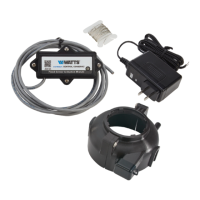RP/IS-957/957RPDA
Installation, Maintenance, and Repair Manual
Series 957, 957RPDA, LF957RPDA
Reduced Pressure Zone Assemblies
Reduced Pressure Detector Assemblies
2
1
⁄2" – 10"
Testing
For eld testing procedure, refer to Watts installation sheets
IS-TK-DL, IS-TK-9A, IS-TK-99E and IS-TK-99D at www.watts.com.
For technical assistance, contact your local Watts representative.
WARNING
!
Read this Manual BEFORE using this equipment.
Failure to read and follow all safety and use information
can result in death, serious personal injury, property
damage, or damage to the equipment.
Keep this Manual for future reference.
Local building or plumbing codes may require modications
to the information provided. You are required to consult
the local building and plumbing codes prior to installa-
tion. If the information provided here is not consistent
with local building or plumbing codes, the local codes
should be followed. This product must be installed by
a licensed contractor in accordance with local codes
and ordinances.
WARNING
!
Need for Periodic Inspection/Maintenance: This product
must be tested periodically in compliance with local codes,
but at least once per year or more as service conditions war-
rant. All products must be retested once maintenance has
been performed. Corrosive water conditions and/or unauthorized
adjustments or repair could render the product ineffective
for the service intended. Regular checking and cleaning of
the product’s internal and external components helps assure
maximum life and proper product function.
WARNING
!
957-OSY-FS
Series 957, 957RPDA, and LF957RPDA each include a ood
sensor on the relief valve to detect excessive discharge and
trigger notication of potential ood events.
NOTICE
For Australia and New Zealand: Pipeline strainers should be
installed between the upstream shutoff valve and the inlet of the
backflow preventer.
Inquire with governing authorities for local installation requirements.
This device must be tested periodically in compliance with
local codes, but at least once per year or more as service
conditions warrant. If installed on a fire sprinkler system, all
mechanical checks, such as alarm checks and backflow
preventers, should be flow tested and inspected internally in
accordance with NFPA 13 and NFPA 25.
WARNING
!
NOTICE
An add-on connection kit is required to activate the flood sensor.
Without the connection kit, the sensor is a passive component that
has no communication with any other device. (A retrofit connection
kit is also available for existing installations. See “Add-on and Retrofit
Sensor Connection Kits,” for ordering details.)
NOTICE
Use of the flood sensor does not replace the need to comply with
all required instructions, codes, and regulations related to instal-
lation, operation, and maintenance of this product, including the
need to provide proper drainage in the event of a discharge.
Watts is not responsible for the failure of alerts due to connectivity
or power issues.
Do not impede or prevent sleeve movement by installing riser
cradle clamps or other obstructive elements on or around the
sleeve. Sleeve movement is required to service the backflow.
WARNING
!



